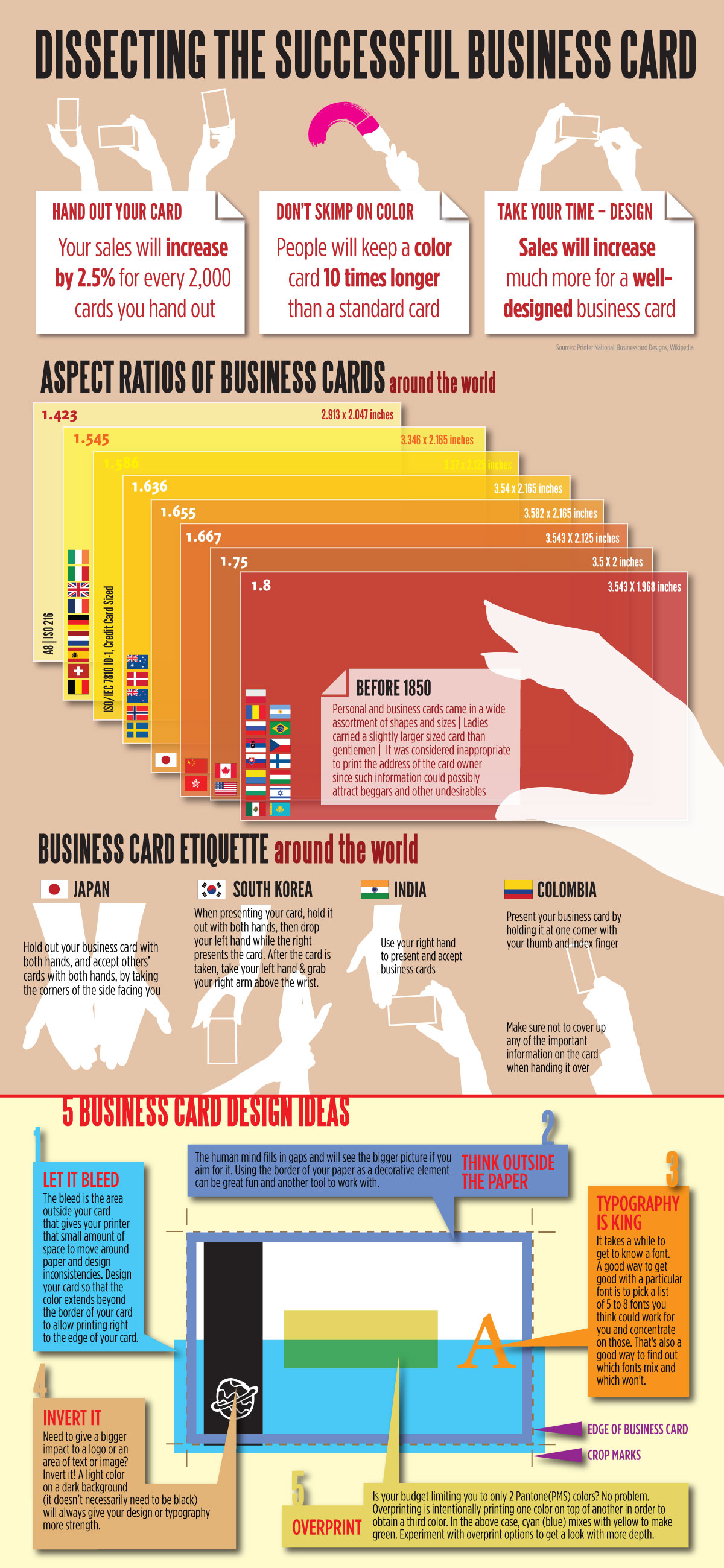 We’ve shared with you inspiration for your business card, insisted that your card doesn’t have to look like a standard card with a lame logo, your face and your phone number. We’ve even told you that there are people like me who keep all business cards anyone ever hands me. There are endless styles ranging from engraved to three dimensional cards and there are many different printers and print qualities.
We’ve shared with you inspiration for your business card, insisted that your card doesn’t have to look like a standard card with a lame logo, your face and your phone number. We’ve even told you that there are people like me who keep all business cards anyone ever hands me. There are endless styles ranging from engraved to three dimensional cards and there are many different printers and print qualities.
But did you know what different cultures have different ways of handing over and receiving business cards? Did you know that how many cards you hand out and the choice of color impact the success of your cards? It’s true!
Lani is the COO and News Director at The American Genius, has co-authored a book, co-founded BASHH, Austin Digital Jobs, Remote Digital Jobs, and is a seasoned business writer and editorialist with a penchant for the irreverent.









































Joe Manausa
March 5, 2011 at 2:22 pm
Wow Lani, and I haven’t been very good at using business cards. I’ve handed out less than 10 this year. I will take your advice to heart. I was at a real estate conference last week and really missed an great opportunity hand out a bunch of cards.
Joe Manausa
March 5, 2011 at 2:25 pm
Lani, a great follow-up for this post would be one with pictured examples of “great” business cards :).
Isaac Torres via Facebook
March 5, 2011 at 7:43 pm
I just had a graphic designer make a new card for me.. I pulled an idea from you! Ty!
Isaac Torres via Facebook
March 5, 2011 at 7:43 pm
I just had a graphic designer make a new card for me.. I pulled an idea from you! Ty!
Krista Lombardi
March 11, 2011 at 12:44 pm
Great info, I’ve got lots of great ideas for my biz cards:)
MH for Movoto
March 14, 2011 at 2:26 pm
Oooh, really enjoyed this. Let’s take a poll of a few snazzy new designs?
An Bui
March 15, 2011 at 1:08 am
Lani, thanks for sharing that infographic! I just finished reading a post about a mobile app that pulls data from business cards. Business cards can lead to meetings and meetings can lead to remembering details about the person you’re about to meet with, right?
Noteleaf, a client, pulls information from your Google Calendar and LinkedIn accounts and sends you comprehensive notifications of what you need to do, where you need to do it and who you need to do it with. (https://techcrunch.com/2011/03/03/noteleaf/)
So the information from your infographic paired with Noteleaf is a good toolset for building relationships 🙂
An
An
Lani Rosales
March 15, 2011 at 9:51 am
Hey An, small world- we wrote about Noteleaf the day before this article above was published (https://agentgenius.com/real-estate-technology-new-media/realtor-tech-tip-let-your-smartphone-tell-you-about-your-client/)… great minds! 😉
Cliff Stevenson
March 15, 2011 at 9:05 am
Very cool. I recently began scanning into my iPhone all the business cards I have received. It was easy, and I’m pretty happy with the ‘rolodex’ being so organized and mobile. What I did notice though, was that several business cards were difficult to handle in the scanning. Usually this was due to what I would call “excessive creativity” (odd fonts, images in behind the information, etc), and some of the problems were due to poor print quality. I wonder if the ease of use in these scanning apps is going to have an effect on people’s design decisions going forward. I wasn’t thinking about my card being scanned when I designed it, but I’ll be thinking about it for the future.
Lily Chen
November 17, 2011 at 3:50 pm
A caveat on idea #2 in the graphic. If you put a thin border around the card, due to the cutting equipment, many print shops cannot cut the cards precisely to make the border exactly uniform, so either you make the border thick enough to allow for the slight variations, or have border on just one or two sides, not all around. In fact many printers advise against having such border around the card design. Just be sure you discuss this with your designer to avoid disappointment.
Pingback: Business Card Design Tips: Top Ideas for Designers in 2016
Pingback: How to choose the perfect colors for your business card – The Digital Agenda
Pingback: How to choose the perfect colors for your business card – Business Card Templates
Pingback: Wie du die perfekten Farben für deine Visitenkarte wählst - 99designs